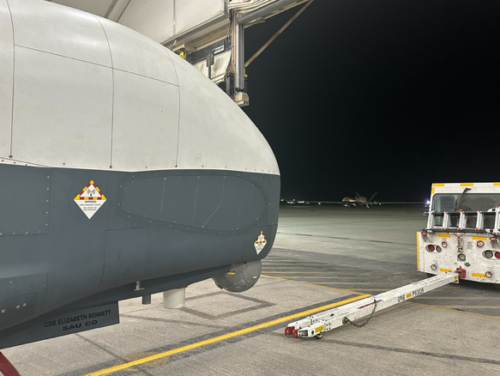Spanning across continents, the U.S. Navy’s MQ-4C Triton unmanned aircraft system has reached a new milestone by establishing a third operational orbit, solidifying its global surveillance capabilities. The Triton, operated by Unmanned Patrol Squadron (VUP) 19 out of NAS Jacksonville, Florida, reached this accomplishment just over a year after its initial operational capability debut in August 2023.

Photo By: U.S. 5th Fleet Public Affairs
An “orbit” signifies a geographically defined area where the MQ-4C Triton UAS maintains a persistent presence, providing uninterrupted surveillance and intelligence gathering. This third orbit, located within the U.S. 5th Fleet area of operations in the U.S. Central Command, joins existing orbits at Andersen Air Force Base in Guam and Naval Air Station (NAS) Sigonella in Italy. This strategic positioning considerably enhances maritime domain awareness for the U.S military.
VUP-19, also known as “Big Red,” achieved the unprecedented milestone of remotely operating simultaneously in three areas of responsibility from its home base. Capt. Ronald Rumfelt, VUP-19’s commanding officer, said of the achievement, “Enabled by the Navy’s Get Real, Get Better charge to think and act differently, and executed by the women and men of ‘Big Red’, the MQ-4C has achieved the unprecedented stand-up of three orbits, vastly increasing the maritime domain awareness for the Joint Force.”
He added, “Additionally, and through capitalizing on U.S. 10th Fleet’s distributed networks, we are rapidly closing the sensor to shooter gap.” The MQ-4C Triton is a critical component of the Navy’s Maritime Patrol and Reconnaissance Force (MPRF), operating alongside the P-8A Poseidon aircraft and the TacMobile ground support system.
This cutting-edge UAS excels in persistent maritime intelligence, surveillance, and reconnaissance (ISR) due to its advanced sensor suite. The MQ-4C Triton is set to replace the aging EP-3E Aries II, assuming the electronic reconnaissance responsibilities previously held by the crewed aircraft. This transition represents a significant shift in the Navy’s approach to maritime surveillance, moving from a platform requiring a crew of around 24 to an unmanned system.
Underscoring the Navy’s commitment to this transition, Northrop Grumman, the company behind the MQ-4C Triton, has been awarded multiple contracts related to the unmanned aircraft system’s development and enhancement. Specifically, in July 2019, Northrop Grumman secured a contract to incorporate Integrated Functional Capability 4.0 into the MQ-4C Triton fleet. This upgrade program includes “material kits and retrofit labor” for both the aircraft and their corresponding ground segments.
For more information, hit the Source below